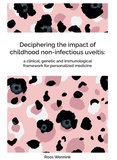Deciphering the impact of childhood non-infectious uveitis
a clinical, genetic and immunological framework for personalized medicine

Wennink, Roos
- Promoter:
- Prof.dr J.H. (Joke) de Boer
- Co-promoter:
- Dr J.J.W. (Jonas) Kuiper
- Date:
- May 17, 2022
- Time:
- 14:15 h
Summary
In this thesis we aimed to gain new insights in the disease burden, clinical course and the molecular aspects of non-infectious uveitis in children, and ultimately molecularly stratify patients, to facilitate tools that will enable personalized medicine. First, to better understand the disease burden we performed a quality of life study and focused specifically on fatigue, which is generally recognized as a frequent and distressing symptom in other childhood chronic auto-immune diseases (chapter 2). Over the past years novel treatments have been developed (i.e. anti-TNF-α therapy) and since ~ 2010 international multidisciplinary guidelines for the recommendation of monitoring and treatment in children with JIA-uveitis became available. To be able to understand the impact of this shift on the prognosis in children with JIA-uveitis, we compared the clinical outcomes (i.e. complications and visual prognosis) in children diagnosed before and after the new guidelines (chapter 3). Anti-TNF-α therapy can be contra-indicated in patients with non-anterior uveitis due to a potentially increased risk of demyelinating disease. Therefore, we describe in chapter 4 the results of tocilizumab (anti-IL6) treatment in children with refractory non-anterior uveitis. To identify patients with refractory uveitis in advance we aimed in chapter 5 to stratify patients at risk for csDMARD failure using a proteomic profile. Next we performed transcriptome profiling of peripheral blood CD19-positive B of patients with JIA with and without uveitis (chapter 6). To identify the role of HLA molecules on uveitis we performed next generation sequencing of children with non-infectious uveitis (chapter 7). All the findings in this thesis are summarized and discussed in chapter 8, in addition to future perspectives.